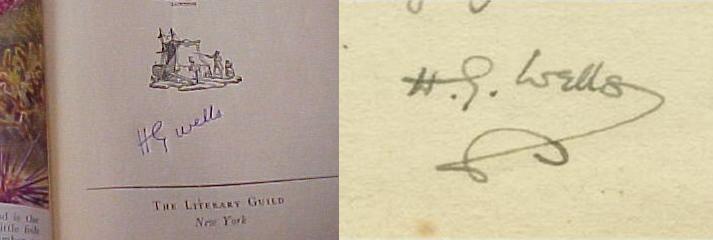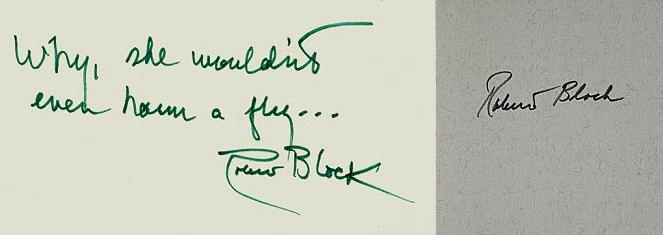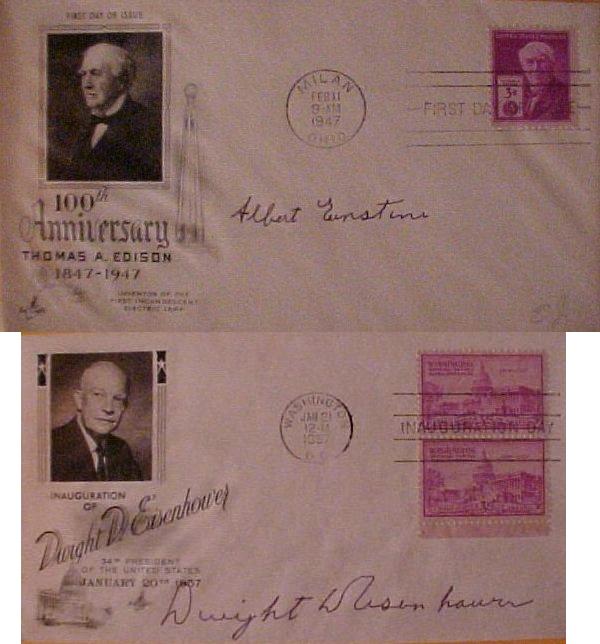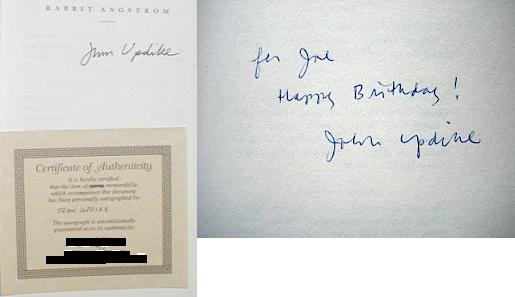Forged Autographs
In 1994, while trying to decide what Christmas gifts to buy for various family members, I saw a notice for an artist appearance/booksigning at the University of Washington Bookstore. Renowned glass artist Dale Chihuly would be there to discuss and sign his new coffee table art book Chihuly Baskets. I figured that a copy might be a nice gift for my father and stepmother, so I went to the event and heard him speak and stood in line for a signature. While waiting in line it struck me how nice an item the book was, and how the addition of his original signature to the book seemed to add value and meaning to the item, giving it distinction, and the potential for the book to become a real heirloom. So I bought a second copy of Chihuly Baskets for myself, plus one copy of each of the three other art books for sale at the bookstore – one copy was inscribed by Chihuly to my father and stepmother, and the other four books were the first volumes in a collection that has been my primary hobby for the past eighteen years.
Living in Seattle and Los Angeles it was easy to collect autographed copies of books. Any author (or artist, or other public figure) on a book tour would typically stop at both of those cities, and in the past two decades at author appearances I obtained signed books and shared a couple words with Stephen King, Allen Ginsberg, Norman Mailer, Gloria Steinem, Steve Martin, Salman Rushdie, and dozens upon dozens more. Some of my favorite experiences were the same sorts of short encounters with somewhat lesser-known names, like Marie Ponsot, Alan Gurganus, and Jon Krakauer. I have boring anecdotes about every single author encounter.
In between author appearances I would comb through used and antiquarian bookstores to shop for already-autographed books, and to find rare first editions to keep in my stock until the author inevitably made his or her way to an appearance in Seattle or Los Angeles to autograph them. For a long time I had a more or less compulsive urge to search through bookstores. It was like a treasure hunt: it was often possible to come across a hidden treasure, a gem of a book undervalued by the seller, a scarce first edition with a hard-to-get signature priced as if it were just any other book on the shelf.
Considering this mania I had for books, it is surprising how late I got around to purchasing books online. My jaunt into buying books online, and into online auctions in particular, changed my habit permanently.
There can be a lot of drawbacks to buying books online, and I had my share of bad experiences buying books through various online bookselling services, but for the purpose of this essay I’m going to limit myself to discussing online auctions. Perhaps more than any other online service, the online auction offers the largest range of items imaginable, all sold from the widest and least controlled/monitored range of vendors. Every day you can find hundreds of thousands of autographed items for sale on eBay – as I type these words, the eBay Collectibles-Autographs section lists 113,000 different autographed items for sale, the Books-Signed section lists another 115,000 items (with little or no crossover), and the Sports Memorabilia-Autographs-Original section offers 780,000 different items.
Thousands of those autographs are fakes. For a while I used to collect scans of the forgeries I saw while shopping on eBay. But there were just too many forgeries, and my sense of disgust and disappointment gradually overpowered my fascination with what I had originally assumed was a quirky criminal niche, so I stopped collecting scans. There is no reason to – there is no hunt involved. There are so many forged signatures on eBay that there is no sport in finding them.
Fortunately, it is often easy to spot forgeries. A little healthy skepticism and intuition will go a long way in helping root out forged autographs, and the following tips might also help:
There was one eBay forgery in particular that really caught my attention early on (before I’d started collecting scans), and initiated my collection of eBay forgery scans. Thomas Harris, the author of The Silence of the Lambs, is a somewhat reclusive author who rarely (if ever) makes the sorts of public appearances that most other authors will do in order to promote their books. Because of this, books autographed by him are more difficult to obtain, and they are considered more valuable than the average autographed novel due to his popularity in combination with the scarcity of such items. While perusing items on eBay purporting to be autographed by him, I clicked on a signed copy of Silence of the Lambs and scrutinized the photos. It was a poor forgery to begin with, but a couple of things stood out to make it particularly noticeable and outrageous: the scan of the autographed page showed an inscription in ballpoint pen reading, “Happy dinning, Thommas Harris”. The forger had a misspelled inscription (‘dinning’ instead of ‘dining’), which Mr. Harris presumably would have been able to manage to avoid doing, and the forger had clearly misspelled the author’s name in what was supposed to have been his signature. More outrageous still was the fact that at least four people had already bid on the item, and the price had reached over $200.
That was one of the few instances that I ever contacted a seller to complain about a forgery in eBay. The seller wrote back, stating that he would look into it, and claiming that it was obtained from another source. I was pleased to notice later that the seller had removed the item. But there are thousands and thousands more terrible forgeries for sale, and at whatever point you are reading this, if you search eBay for Thomas Harris autographs you will see that most of them look inconsistent and suspect. That is because almost all of them are fakes.
1) Was the autographed item published/produced while the subject was still alive? On more than one occasion I have seen forgeries in posthumous publications. There are notable exceptions, all limited-edition releases direct from the publishers – Kurt Vonnegut’s last two short story collections were offered as signed limited editions by the Easton Press, who bound the pre-signed pages into the books two- and four years after his death; The Selected Letters of Philip K. Dick was published in very limited editions many years after dick’s death with tipped-in signatures cut from old checks obtained from his estate; also the 35-volume Sussex edition of The Works of Rudyard Kipling, where Kipling signed the limitation pages and then passed away before it could be published. There are probably more instances, but you get the idea.
2) Is the writing instrument and/or autographed surface contemporary to the life of the signer? Does the supposedly 50-year-old signature appear to be written on a suspiciously bright white sheet of paper? Or is something else incongruous? Example:

H. G. Wells, author of several literary classics, passed away in 1946. Ballpoint pens were not commonly used until around 1950. This signature, in bright blue ballpoint pen in a copy of The Science of Life (published in 1930) is clearly a forgery for more reasons than the writing instrument, but that pen should set off the first alarm bell.
3) Does the subject matter seem unlikely? Did the subject of an unflattering biography inscribe a copy of that biography? Years ago, a seller on eBay was offering printed quotes with actual signatures. One such item was the quote, “I did not have sexual relations with that woman,” with a Bill Clinton autograph beneath it. This had to have been a forgery because Clinton would never have autographed such an item. If you argue that maybe Clinton signed the bottom of a blank sheet of paper and someone printed that quote over his signature, you would have to believe that someone would be able to convince Clinton to sign the bottom of a sheet of blank paper. Unlikely.
We have all been signing our names for our entire lives, and we are all very comfortable with our signatures. Celebrities, politicians, authors and athletes sign autographs a lot, so most of them have honed it to a scrawl that only takes a second to execute.
This speed, comfort and confidence are what most forgers lack, and it is visible in the signatures themselves. Take this example:

Kurt Vonnegut, Jr. was the very famous, popular author who wrote Slaughterhouse-5, Cat’s Cradle, and a number of popular quirky books. His signature is considered valuable, and that value increases tenfold for the comparably rare autographs that included one of his trademark self-caricatures as part of the signature.
The example on the left is the forgery. At first glance, it sort of looks worse than the genuine signature on the right, but what can we point to, specifically, as evidence that it is a forgery? We can actually see the lack of speed, comfort and confidence.
When Vonnegut signed his autograph on the right, we can see that it was done quickly and confidently. The speed is apparent in the bridge of the nose and curls of his hair, where the ink lightens slightly with the added speed of the strokes of the pen. We can see that the entire piece was executed in a few efficient moves. Vonnegut produced the autograph and caricature in a couple of seconds flat, as he had done thousands of times before.
In contrast, the example on the left was completed more slowly and methodically. You can see where the pen stopped and re-started in the uppermost whorl of hair. You can see the comparative lack of confidence in each line; we can imagine the forger looking back and forth between a copy of the real signature and the forgery in progress before him or her. You can see the effort and the hesitation in those lines, which are missing in the genuine article.

Norman Mailer won two Pulitzer Prizes. He wrote The Naked And The Dead, The Executioner’s Song, and Armies of the Night. The forgery on the left is typical of many forgeries of many signatures. As with the Vonnegut forgery, it is missing the speed and confidence of the genuine signature. There is a slight but visible shakiness apparent in the line that was the result of concentration and effort – concentration and effort that is always missing from a real signature.
Another thing apparent about the signature on the left is the uniformity of the thing. There is no variation in the ink that is apparent in a speedy signature. Regardless of the writing instrument, the individual lines of any scribble done quickly will be noticeably different than the individual lines of a similar scribble done slowly and deliberately.

Gore Vidal and John Updike are/were prizewinning novelists and American men of letters for decades. The forgeries on the left are bad enough, but they are also excellent examples of another common forger error, which is the mid-signature pause. When most people sign anything, the autograph is whipped out in a second flat. The forgers on the left, perhaps comparing their efforts to a genuine signature while they were forging their examples, stopped mid-signature and let the ink seep little blotches into the middle of the autographs. This is a dead giveaway.

Robert Bloch wrote Psycho. He spelled his name Bloch, not ‘Block’. This forger went the extra mile to forge an entire quote from the novel, and then blew it on the very last letter.

Years ago this forger put several signed First Day Covers up for sale on eBay. These ballpoint signatures look heavy, and it makes me believe that they were either traced, or perhaps a photocopy of a signature was traced on top of the first day cover, and the forger then inked the signature over the impression made by the pen. However they were done, the hesitation is still visible, the writing instrument is suspect, and it is completely unconvincing.

This forgery is just awful. The eBay listing claimed that Hemingway was drunk when he signed the book. The better guess is that the forger had to have been high to think anyone would believe that story.

Certificates of authenticity only mean that the forger has a laser printer.
If you care about autographs, trust your gut. If something looks odd, then it is probably not genuine. And even if it might be genuine, you will always be suspicious of it, so it is not worth the doubt.